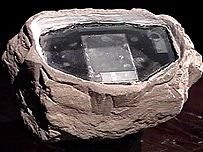 (Right) A
flap concealed the technology inside the alleged fake rock (Right) A
flap concealed the technology inside the alleged fake rock
-
- Russia's intelligence agency, the FSB, has accused British
agents of storing and exchanging classified information using a fake rock
on a Russian street.
-
- It says the hi-tech stone is "absolutely new spy
technology". The UK has not commented on the rock allegation.
-
- The BBC News website's technology correspondent Mark
Ward considers how such a rock might work, and the potential pitfalls of
such technology.
-
- Q: What kinds of devices could be used for this?
-
- A: Any gadget that can swap data wirelessly would be
able to work with the rock but the most likely candidates would be mobile
phones and handheld computers - known as Personal Digital Assistants (PDAs)
. These are used very widely and it has become easy to use them to move
data - be it a text message or an image or video clip - over short and
long distances.
-
- To avoid looking suspicious, those involved in the alleged
data theft might have turned to a widely available gadget because the basic
data transfer capabilities would have been built in and it would need minimal
tweaking to get working. Many phone and PDA users regularly swap data,
such as contact details or images, via Bluetooth short-range radio or via
infra-red.
-
- Q: What capacity do such devices have?
-
- A: The latest devices can use wi-fi or even newer technologies
to move data around faster. All can transfer many thousands of bytes of
data per second. One byte is equal to one character and one million characters
is roughly equivalent to the amount of data in a large paperback book.
-
- Q: How would it work?
-
- A: Without more details it is hard to be precise about
how a rock and phone/PDA combination might work.
-
- However, from what we know it appears that those who
allegedly stole the confidential information walked close to the rock and
then uploaded data to the device beneath it. Later, others came and downloaded
the data and walked off with it.
-
- It is most likely that radio of some kind was used to
pass data back and forth. Infra-red demands a line of sight between the
devices swapping data and would not penetrate the fake surface of the rock.
-
- Many investigation firms use custom-built devices when
trying to spot insurance fraud. Some have made "smart bricks"
with cameras concealed in them which they toss into a suspect's garden.
Typically these use short range radio to send images back to a van close
by.
-
- Q: What are the potential problems with this sort of
thing?
-
- A: The main problem is likely to be the battery life
for the device beneath the rock that stores the data. Sending data via
short-range radio is a notorious gobbler of battery power. If lots of data
were being passed back and forth the useful life of the rock could be very
short.
-
- Q: Are there any other problems, more specific to this
situation?
-
- A: Yes. One is the speed at which data can be uploaded
or downloaded. While standing in the street tapping on a phone or PDA does
not raise much comment any more, it would if you had to stay in the same
place for hours. But using faster speeds tends to be even more battery
hungry.
-
- Another problem is ensuring that only the right people
upload and download data. Unprotected wi-fi networks are notoriously easy
to find and log on to. It might prove hard to find ways to continually
update the alleged spies on regularly changing passwords, encryption keys
and the like.
-
- The final problem is the clumsiness of this method for
passing data. If a PDA has a wireless link there are likely to be lots
of public places that would allow that data be sent more anonymously. For
instance, many tech-savvy criminal gangs use hijacked servers to store
stolen data.
|